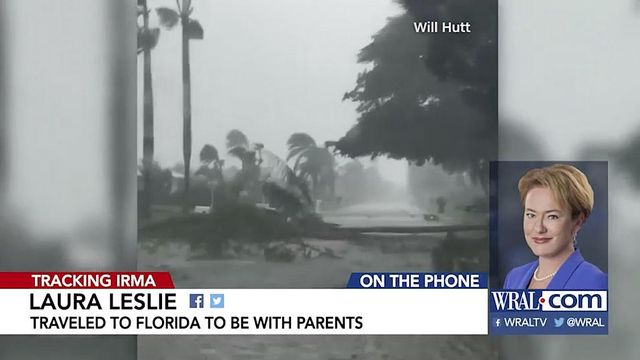Leslie: Hurricane hacks and other things Irma taught me
Last Thursday, I arrived in Fort Myers where my elderly parents live. My mom had just badly broken her arm, and my stepdad doesn't really drive, so my plan was to bundle them into their car and drive them back to North Carolina until Irma was over and the power came back on.
Posted — UpdatedLast Thursday, I arrived in Fort Myers, Fla., where my elderly parents live. My mom had just badly broken her arm, and my stepdad doesn't really drive, so my plan was to bundle them into their car and drive them back to North Carolina until Hurricane Irma was over and the power came back on.
My parents had different plans: They refused to leave.
Because of Mom’s accident, they hadn’t really prepared. Their supplies were minimal. But they pointed to forecasts that said the storm would hit the state’s east coast, not their west coast town.
The forecast changed Friday night, putting Fort Myers in the crosshairs. Saturday at noon, their neighborhood was put under immediate mandatory evacuation. We scrambled to find a place to stay and to get a few things packed up.
The rest is a long story. We all came through it just fine, but it was a long, difficult week. And I learned a few lessons along the way that I didn’t learn from standard hurricane prep or from covering storms for news.
One partial solution is to get some 5-gallon pails from your local home improvement store. (Get lids, too, if you can.) You can fill them up before the storm hits and you get put under a boil-water advisory. You’ll still want some smaller bottles and jugs in case you have to evacuate, but a few of these buckets can buy you a week of safe water when you get home.
Put a dime on top of an ice cube tray or a small container of water you’ve frozen for this. When the power comes back on, check the dime. If it’s still on top of the ice cube or the dish, your freezer stayed frozen, so you don’t have to toss all that food. If the dime is in or under the ice, then your freezer thawed out and then refroze, so the food may not be safe to use.
If you are told to evacuate on short notice, you will have neither the time nor the mental bandwidth to go hunting for this stuff. You will be too busy figuring out where and when you’re going, packing clothes and bedding, loading the car and so on.
Also, be sure to follow emergency services and utilities on Facebook and Twitter. When conditions are changing quickly, social media pages are more likely to have the latest information than websites.
Related Topics
• Credits
Copyright 2024 by Capitol Broadcasting Company. All rights reserved. This material may not be published, broadcast, rewritten or redistributed.






